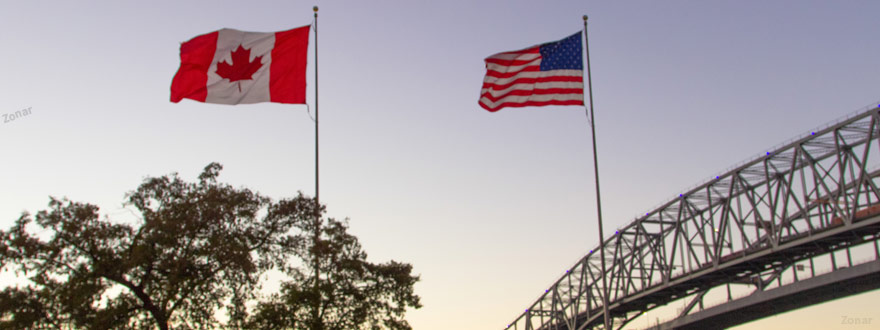Top 5 differences between U.S. and Canadian ELD

Avoid ELD violations by knowing the details.
The Canadian ELD looks much like the U.S. ELD, but there are key differences between the two. Each country evaluates driver HoS logs based on its own regulations—not where the driving occurred. When drivers cross the border in either direction, these differences may or may not be in their favor. And can earn a violation.
For now, all Canadian jurisdictions support education and awareness over corrective action. That will change starting January 1, 2023. Now’s a good time to familiarize yourself (and your drivers) with the main differences between the U.S. ELD and the Canadian ELD regulations, so your drivers can avoid violations when law enforcement starts issuing citations.
Compare the top 5 differences side by side.
The table below features a side-by-side comparison of the key differences. However, this list is not all inclusive. Work with your ELD provider to ensure compliance with the rules and regulations that apply to your fleet. Ideally, your provider will support its ELD technology and have a team of in-house experts who can provide guidance and education around both sets of regulations.
| Personal conveyance (PC) | |
|
U.S. ELD
|
Canadian ELD
|
| Available logs | |
|
U.S. ELD
Must have 7 days, plus the current day of logs available at roadside or any time requested by an official |
Canadian ELD
Must have 14 days, plus the current day of logs available at roadside or any time requested by an official |
| Split sleeper berth | |
|
U.S. ELD
May split sleeper berth in only two manners: either 8/2 or 7/3 |
Canadian ELD
May split sleeper berth in any two time periods, equaling 10 total hours |
| Deferral | |
|
U.S. ELD
Not allowed |
Canadian ELD
May defer up to 2 hours of rest time to the next day |
| Certification | |
|
U.S. ELD
Allows self-certification |
Canadian ELD
|
| Learn more about the U.S. ELD regulations on the FMCSA website. | Learn more about the Canadian ELD regulations on the Government of Canada website. |
|---|---|
Know the terminology to understand the differences.
Personal conveyance (PC): The movement of a commercial motor vehicle (CMV) for personal use while off-duty. Read our online article about Personal Conveyance Best Practices. Also learn more about the FMCSA’s personal conveyance and HoS regulations.
Available logs: Timeframe for which the CMV driver must present recorded hours of service during roadside inspections and when requested by an official.
Split sleeper berth: Allows drivers to take an off-duty break in the truck’s sleeper berth for a specified period of time, within a predetermined timeframe. Drivers may split that total off-duty time as allowed under that country’s ELD regulations.
Deferral: Canadian ELD regulations allow drivers, who are not splitting their off-duty time in the sleeper berth, to defer taking up to 2 hours of their daily off-duty time from one day to the following day if certain conditions are met. U.S. ELD regulations do not permit deferrals.
Certification: Demonstrates that a provider’s ELD device and application meet the technical specifications for that country’s ELD regulations.
Simplify compliance on each side of the border.
Avoid citations with the right ELD. Zonar Logs™, our Hours-of-Service (HoS) application, meets Canadian ELD regulations for Cycle 1 and Cycle 2. And is third-party certified by Transport Canada’s accreditation body, COMDriver, for use by Canadian fleets and federally regulated carriers crossing the U.S. and Canada border. (Read the press release.)
Zonar Logs is also a proven solution for compliance with the U.S. ELD regulations.
- Self-certified and third-party validated with the FMCSA
- Successfully completed testing with the FMCSA to confirm end-to-end data transfer to an authorized safety official’s laptop via web services
- Meets title 49 CFR 395 Electronic Logging Devices and Hours-of-Service Certification
Zonar Logs supports various rulesets and exemptions for U.S. intrastate, interstate and passenger carrying fleets. And automatically updates itself as laws change, so you can stay in compliance without being caught off guard.
Work with experts who helped shape the regulations.
Our dedicated team of Safety and Compliance experts know the HoS regulations for both countries, inside and out. They helped shaped them, and they informed how we developed Zonar Logs to make compliance easier on you, your drivers and law enforcement officials.
This team will work with you even after ELD installation to help you support your drivers, here and across the border. Set up your free consultation today.
More resources and reading
Meet our in-house team of Safety and Compliance experts
More on how Zonar is ready for the Canadian ELD mandate
Read how Zonar has been working to help you prepare
Read our Zonar Logs Receives Third Party Certification from Transport Canada press release
Learn more about Canada’s ELD regulations and U.S. ELD regulations





